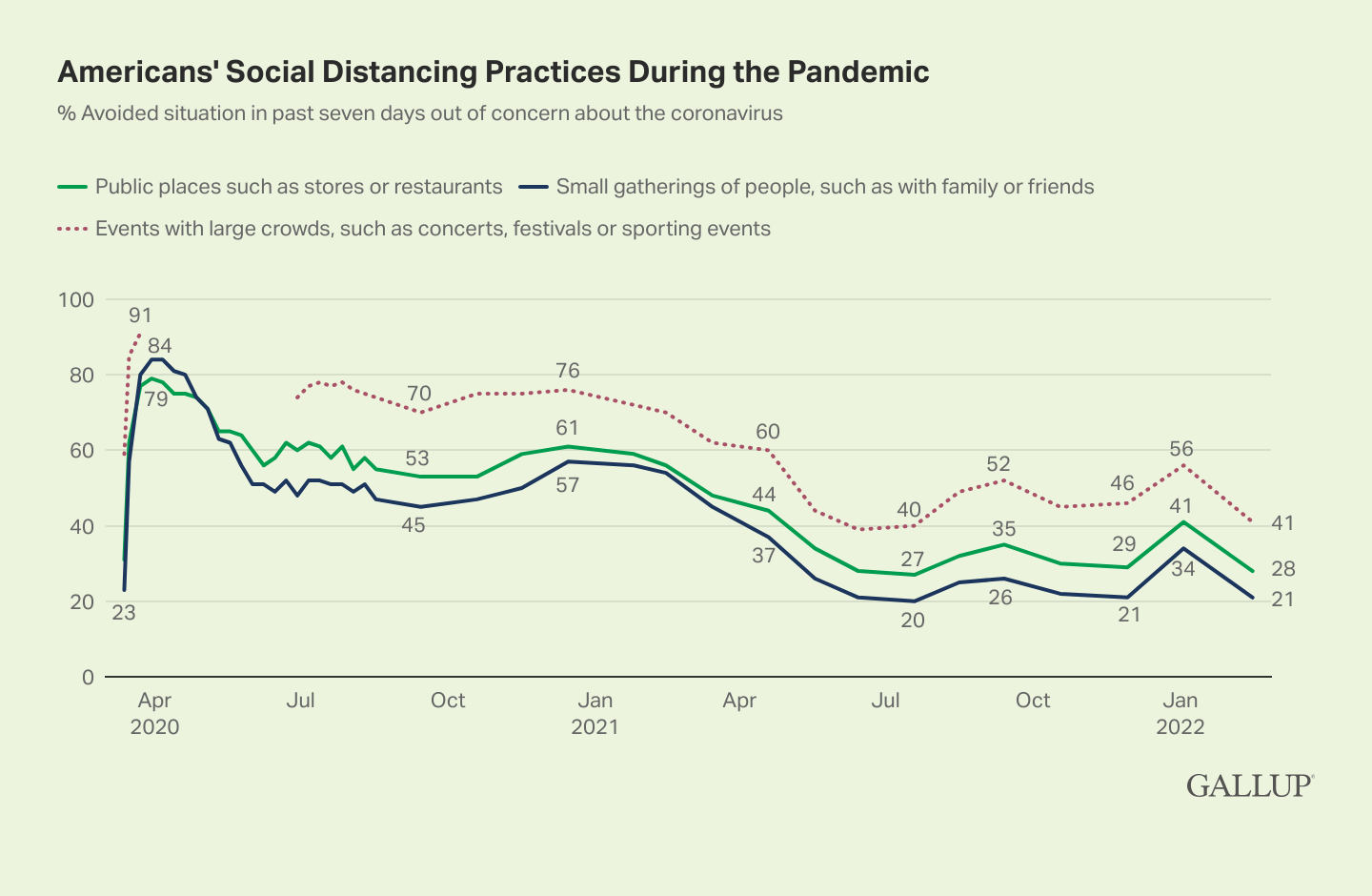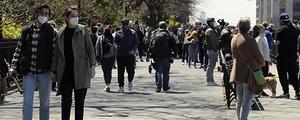Story Highlights
- 41% now avoiding events with large crowds, down from 56% in January
- Fewer also avoiding public places and small gatherings
- Mask-wearing remains common, but not with Republicans
WASHINGTON, D.C. -- Americans' agility in responding to changing COVID-19 threat levels is on full display as the world approaches the two-year anniversary of the World Health Organization declaring the novel coronavirus outbreak a global pandemic. After dialing up their social distancing behaviors in January, Americans dialed them back down in February and are now the least cautious they have been since last July.

Line graph. Trend from March 2020 to February 2022 in the percentage of Americans avoiding three types of activities due to their concern about the coronavirus. The percentage avoiding going to events with large crowds has fallen from 91% in March 2020 and 72% at the start of 2021 to 41% today. Those avoiding going to public places has fallen from 79% near the start of the pandemic to 59% in January 2021 and 28% today. Those avoiding small gatherings has fallen from a high of 84% in April 2020 to 56% in January 2021 to 21% today.
The percentages of adults avoiding events with large crowds, public places such as stores and restaurants, and small gatherings of people all increased by 10 or more percentage points in January as the highly infectious omicron variant spurred record-high cases and hospitalizations, raising public alarm.
With the omicron wave diminishing in February and Americans expressing renewed optimism about the course of the pandemic, social distancing returned to December levels or declined further:
- 41% are now avoiding events with large crowds, such as concerts, festivals and sporting events
- 28% are avoiding stores, restaurants and other public places
- 21% are avoiding small gatherings of people, such as with friends and family
The latest results are based on a nationally representative survey of U.S. adults conducted Feb. 15-23 by web using the Gallup Panel. Americans' reports of their social distancing are now on par with the lowest of the pandemic, recorded last summer before the delta variant wreaked havoc on the recovery.
Less Than Half Not Doing Any Social Distancing
The same poll asked Americans to describe their attempt at self-isolation more generally. Twenty-two percent report that they are completely or mostly isolating from non-household members, and 34% are partially isolating or isolating a little. Forty-four percent are making no attempt at isolating.
While this question was not asked in the January survey (and thus may not capture heightened caution that month), the trend since the start of the pandemic confirms that the percentage of adults following strict social distancing protocols remains near the low point found last summer.

Line graph. Trend since March 2020 in amount Americans are isolating from others. The percentage completely or mostly isolating surged to 75% in April 2020 and then quickly fell to 40% in June 2020. It remained in the 40% to 50% range until early 2021 but then fell through the first half of the year reaching 18% in June. It has since remained low, including 22% in February 2022. Meanwhile, the percentage isolating a little or partially has been steady near 35% since late 2020 while the percentage making no attempt at isolating has increased from 15% to the low to mid 40s, including 44% in February.
Face Mask Usage Still Common
Despite the ups and downs in Americans' avoidance of social encounters, the percentage reporting they wore a face mask in the past seven days when away from home has been fairly steady since last June.
Almost every month since then, approximately seven in 10 adults have reported wearing a face mask when outside their home -- the exception being July, when it dipped to 60%. Since then, the rate has varied between 68% and 73%, with February on the low end of that range.

Line graph. Trend from April 2020 to May 2021 in the percentage of U.S. adults reporting they wore a mask in the past seven days when outside of their home out of concern about the coronavirus. Mask usage rose from 51% in mid-April 2020 to 93% in August 2020 after which it remained high until mid-2021. It fell to 60% in July 2021 before rising back to 69% in August. It has since remained near that level, including 68% in February 2022.
Precautionary Behavior Still Varies by Subgroup
Consistent with what Gallup has found previously, Democrats -- as well as several Democratic-leaning groups (women, city residents and fully vaccinated Americans) -- remain more likely than others to engage in some or all of the four precautionary behaviors.
- Party ID: Democrats are more than twice as likely as Republicans to wear a face mask (91% vs. 41%, respectively), and they are three times as likely to avoid crowds, public places and small gatherings. Independents' reports of taking these precautions fall about halfway between the two partisan groups'.
- Gender: Women are significantly more likely than men to wear a face mask when outside their home (by 16 points) and to avoid large crowds (11 points), while they are slightly more likely to avoid public places like restaurants and stores (five points) and to avoid small gatherings (four points).
- Community type: Adults living in cities are slightly more likely than suburban residents to avoid public places and large crowds, as well as to wear a face mask. Both groups are more likely than rural residents to engage in all four social distancing behaviors.
- Vaccination status: People who are fully vaccinated and have received a booster, as well as those who aren't vaccinated but plan to be, are much more likely than other Americans to avoid various social settings and wear a mask. Adults who are fully vaccinated but not boosted are somewhat less stringent about social distancing, while those who don't plan to get vaccinated are the least likely to be taking precautions.
| Avoided small gatherings |
Avoided public places |
Avoided large crowds |
Worn a mask |
|
|---|---|---|---|---|
| % | % | % | % | |
| U.S. adults | 21 | 28 | 41 | 68 |
| Party ID | ||||
| Democrats | 31 | 39 | 60 | 91 |
| Independents | 20 | 26 | 35 | 65 |
| Republicans | 9 | 13 | 20 | 41 |
| Gender | ||||
| Men | 19 | 25 | 35 | 60 |
| Women | 23 | 30 | 46 | 76 |
| Community type | ||||
| City | 24 | 32 | 46 | 79 |
| Suburb | 23 | 28 | 42 | 73 |
| Small town/Rural area | 18 | 25 | 36 | 59 |
| Vaccination status | ||||
| Fully vaccinated, received booster | 25 | 35 | 53 | 86 |
| Fully vaccinated, no booster | 18 | 23 | 34 | 61 |
| Plan to get vaccinated | 28 | 31 | 52 | 82 |
| Do not plan to get vaccinated | 9 | 10 | 14 | 26 |
| Feb. 15-23, 2022 Full wordings: Avoided going to public places such as stores or restaurants; Avoided small gatherings of people, such as with family or friends; Avoided going to events with large crowds, such as concerts, festivals or sporting events; Worn a mask on your face when outside your home Note: Adults partially vaccinated not shown due to low sample size |
||||
| Gallup | ||||
Bottom Line
Americans' social distancing practices have been responsive to reported levels of coronavirus cases throughout the pandemic, and that continues in 2022. Gallup tracking found Americans stepping up their avoidance of social encounters in January as cases nationally reached unprecedented levels due to the highly infectious omicron variant. They then reduced their adherence to social restrictions in February as cases plummeted.
The pattern echoes the situation last fall with the onset of the delta variant, when Americans reported avoiding various public and social settings more than they had over the summer. This too subsided over the next few months. But the latest cycle of intensification of social distancing followed by relaxation was even more compressed.
Such agility in using their social distancing tools could be part of the new normal for Americans as society organizes itself around the recognition that the coronavirus won't be going away for the foreseeable future.
To stay up to date with the latest Gallup News insights and updates, follow us on Twitter.
Learn more about how the Gallup Panel works.




